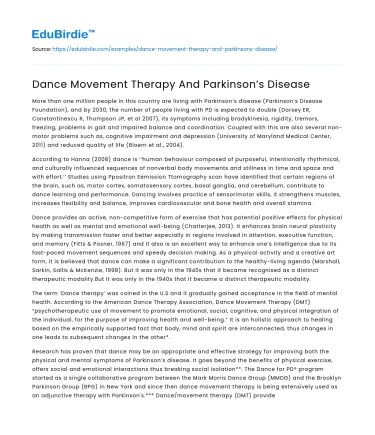More than one million people in this country are living with Parkinson’s disease (Parkinson’s Disease Foundation), and by 2030, the number of people living with PD is expected to double (Dorsey ER, Constantinescu R, Thompson JP, et al 2007), its symptoms including bradykinesia, rigidity, tremors, freezing, problems in gait and impaired balance and coordination. Coupled with this are also several non-motor problems such as, cognitive impairment and depression (University of Maryland Medical Center, 2011) and reduced quality of life (Bloem et al., 2004).
According to Hanna (2008) dance is ‘‘human behaviour composed of purposeful, intentionally rhythmical, and culturally influenced sequences of nonverbal body movements and stillness in time and space and with effort.’’ Studies using Ppositron Eemission Ttomography scan have identified that certain regions of the brain, such as, motor cortex, somatosensory cortex, basal ganglia, and cerebellum, contribute to dance learning and performance. Dancing involves practice of sensorimotor skills, it strengthens muscles, increases flexibility and balance, improves cardiovascular and bone health and overall stamina.
Save your time!
We can take care of your essay
- Proper editing and formatting
- Free revision, title page, and bibliography
- Flexible prices and money-back guarantee
Dance provides an active, non-competitive form of exercise that has potential positive effects for physical health as well as mental and emotional well-being (Chatterjee, 2013). It enhances brain neural plasticity by making transmission faster and better especially in regions involved in attention, executive function, and memory (Fitts & Posner, 1967) and it also is an excellent way to enhance one’s intelligence due to its fast-paced movement sequences and speedy decision making. As a physical activity and a creative art form, it is believed that dance can make a significant contribution to the healthy-living agenda (Marshall, Sarkin, Sallis & McKenzie, 1998). But it was only in the 1940s that it became recognised as a distinct therapeutic modality.But it was only in the 1940s that it became a distinct therapeutic modality.
The term ‘Dance therapy’ was coined in the U.S and it gradually gained acceptance in the field of mental health. According to the American Dance Therapy Association, Dance Movement Therapy (DMT) “psychotherapeutic use of movement to promote emotional, social, cognitive, and physical integration of the individual, for the purpose of improving health and well-being.” It is an holistic approach to healing based on the empirically supported fact that body, mind and spirit are interconnected, thus changes in one leads to subsequent changes in the other*.
Research has proven that dance may be an appropriate and effective strategy for improving both the physical and mental symptoms of Parkinson’s disease. It goes beyond the benefits of physical exercise, offers social and emotional interactions thus breaking social isolation**. The Dance for PD® program started as a single collaborative program between the Mark Morris Dance Group (MMDG) and the Brooklyn Parkinson Group (BPG) in New York and since then dance movement therapy is being extensively used as an adjunctive therapy with Parkinson's.*** Dance/movement therapy (DMT) provides a secure, confidential and non-judgemental space provides a safe and supportive psychological structure for people with PD Parkinson’s disease to express different thoughts, feelings and emotions about their disease and their lives: frustrations, joys, anger and laughter. The use of movement as the primary means of communication, benefits persons with Parkinson’s disease doubly, as “dancing” - an expressive and rhythmic sequencing of motions to music – seems to organize movements, calm dystonia and improve gait and balance.
Rhythmic music enables and facilitates entrainment and precise synchronization of movements (Madison et al., 2011) and may be specifically important for patients with PD because of the problems in sensory-motor timing (Lucas et al., 2013; Hove and Keller, 2015). Finally, practice of dance, with music providing an external cue and an emotional context, may facilitate activation of areas that normally show reduced activation in PD, for example the putamen, and may temporarily alter mood (Krumhansl, 2000; Laukka, 2006; Zentner et al., 2008) through activation of specific brain areas such as amygdala, hypothalamus, hippocampus, insula, cingulate cortex, and orbitofrontal cortex (Blood and Zatorre, 2001; Koelsch, 2014). This activation includes the release of several biochemical mediators (e.g., endorphins, endocannabinoids, dopamine, and nitric oxide; Boso et al., 2006).






 Stuck on your essay?
Stuck on your essay?

